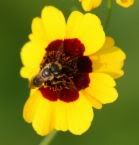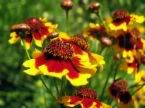

Scientic Name
Coreopsis tinctoria
Uses of Golden Tickseed: Landscaping, Medicinal, Culinary, etc...
This plant is used mainly for landscape beautification. It has potential for use in cultivated, garden situations, in naturalized prairie or meadow plantings, and along roadsides.
General Characteristics
Sunflower Family (Asteraceae). Calliopsis is an annual forb which usually germinates in late summer or fall and over-winters as a rosette (round, low growing group of leaves). This is a U.S. native. The stems begin growing upward and branching in spring, reaching a height of up to 4 feet. The opposite leaves are deeply divided, with the upper leaf segments being very narrow. The flowering heads are numerous, 1-2 inches in diameter, and are yellow with a red-brown center.
Required Growing Conditions
Calliopsis is adapted to many soil types. It grows best on a well-drained soil, but will not tolerate a very dry site. Natural stands are generally found on bottomland areas with ample moisture. It grows best in full sun, but will tolerate light shade.
Calliopsis is distributed throughout the majority of the United States.
Cultivation and Care
A firm seedbed is required. Calliopsis germinates best on a clean tilled site that has been firmed with a roller or finishing harrow before planting. Seed can also be planted into a closely mowed, chemically-killed, or burned sod area with a light disking or harrowing that scratches the soil surface. A layer of plant residue on the soil surface can interfere with seed germination. Broadcast or shallowly drill 1-2 grams per 100 square feet (1-2 lb/acre). Seed should be placed close to the soil surface. Cultipacking after planting will ensure good seed to soil contact. Seed will germinate soon after planting and remain as a rosette throughout the winter.
General Upkeep and Control
Plant growth and seed production are greatly improved by fertilization. Apply fertilizer according to soil test recommendations. If not available, a rate of 3.5-5.5 oz per 100 square feet (100-150 lb/acre) of 13-13-13 should be applied in the spring before flowering. Stands will reseed prolifically for several years, but will gradually decline without soil disturbance. Every two to three years, the site should be disked to control perennial weeds and promote calliopsis germination. If necessary, plants can be mowed in the spring before stem elongation begins. Stands that are not disked should be mowed in late summer, and a late fall mowing is also recommended.
Environmental Concerns Several sources consider this species to have invasive qualities. Please consult the Plant Profile for this species.





6 comments:
Unknown said...
Mau Banyak Bonus?, Yuk Gabung Disini >> ayam bangkok petarung
waawaw said...
sabung ayam pw yuk main
susuultra said...
Bosan Menang tidak dibayar ? judi sabung ayam
sabung ayam said...
ayam bangkok adu
Unknown said...
nonton video sabung ayam bangkok
Midnight Story said...
Daftar Togel Online
Agen Togel Hongkong
Agen Togel Singapura
Museumbola Slot Pragmatic
Museumbola Slot Pulsa
Museumbola Joker123
AKSES SEGERA SITUS KAMI 1 ID BANYAK PERMAINAN
WA OFFICIAL : +6283157394921